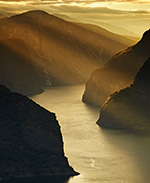
On the origin and demise of coasts
Special allure
Coasts are a special habitat. They are the transition area between land and sea and are influenced by both realms. Rivers carry nutrients from the land to the coastal waters and thus represent the basis of the marine food chain. The seas transport sediments – washing them ashore, reworking them or carrying them away, all of which change the shape of the coast.
No other marine environment is more productive. Coasts provide nourishment in the form of fish and other seafood. But they are also important transportation routes for shipping and are intensively exploited for the production of natural gas and oil. At the same time, the coasts are highly desirable recreation areas for millions of vacationers. Numerous cities have been built on the coasts, and industries and power plants take advantage of their often well developed infrastructures.
- 1.1 > Many cities developed in coastal areas. The Beyog˘lu district of Istanbul, for example, is thousands of years old. It lies on the Golden Horn, a fjord-like inlet that divides the European part of the city into southern and northern areas.
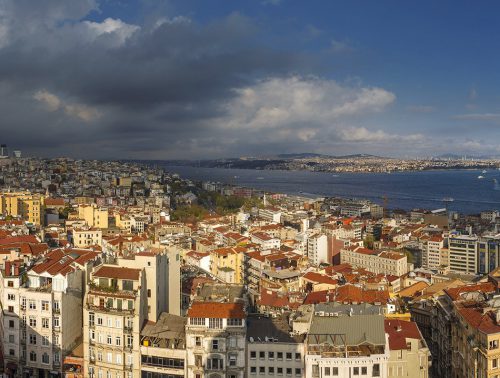
- In general, the coastal zones of the Earth are extremely variable in shape and form. They are of great importance for humans, animals and plants, as well as for the atmosphere and climate because:
- they comprise around 20 per cent of the Earth’s surface;
- they represent important transportation routes and sites for industry;
- they are attractive recreation and tourist areas;
- they are sources for mineral and fossil raw materials;
- they encompass key ecosystems with great species diversity;
- they act as important sediment traps that consolidate river sediments;
- in their role as a buffer between the land and sea, they affect many global parameters;
- 75 per cent of all megacities (populations greater than ten million) are located in coastal zones;
- 90 per cent of global fisheries operate in coastal waters.
The coast – where does it start, where does it end?
As a rule, maps depict coasts as lines that separate the mainland from the water. The coast, however, is not a sharp line, but a zone of variable width between land and water. It is difficult to distinctly define the boundaries of this transition zone. In the 1950s, scientists suggested using a definition of coast as the area that is influenced by the surf. Landward, this includes the extent to which the airborne saltwater spray can reach, thus encompassing some vegetation on the land. Seaward, this would extend to the area where the surf makes itself noticeable, for example, where it contributes to shaping the sea floor.
Although efforts are being made to establish a theoretical and universally accepted definition for the term “coast”, in practice disparate conceptions come into play. Different aspects predominate in science, depending on the particular sub-discipline being applied. Biologists, for example, concentrate primarily on life in the sea or in wetland areas along the coasts or in estuaries. Coastal protection specialists, on the other hand, who make plans for dykes and other protective infrastructures, are also interested in the hinterland to the extent that it could be impacted by storm floods. Economists have an especially broad definition of the term “coast”. As a rule they consider not only harbours and industrial areas near the coast, but also the flow of goods over the sea or to inland regions.
Over the past several decades, geologists and oceanographers have also attempted to systematically delineate and catalogue the world’s coasts. Here there are also different approaches depending on the focus of the effort. Coastal types are differentiated based on whether they are characterized by “high-energy” formations such as rocky or sandy coasts that are directly bathed by the surf or, like the Wadden Sea, are characterized by relatively calm, “low-energy” areas that are protected by sand banks or offshore islands.
In spite of their differences, many coasts have one thing in common: their great importance for humans. Coasts have been the starting points for explorers and the targets for conquerors. Archaeologists and ethnologists believe that the coasts have played a great role in the settlement of new continents or islands for millennia. Before people penetrated deep into the inland areas they travelled along the coasts searching for suitable locations for settlements. The oldest known evidence of this kind of settlement history is found today in northern Australia, where the ancestors of the aborigines settled about 50,000 to 40,000 years ago, presumably arriving on boats from islands that today are part of Indonesia.
- 1.2 > Alfred Wegener (1880–1930) was a German meteorologist, polar researcher and geoscientist. He proposed the scientific principle of continental drift. His theory, however, was long considered a foolish idea. It was not generally accepted until the 1970s.
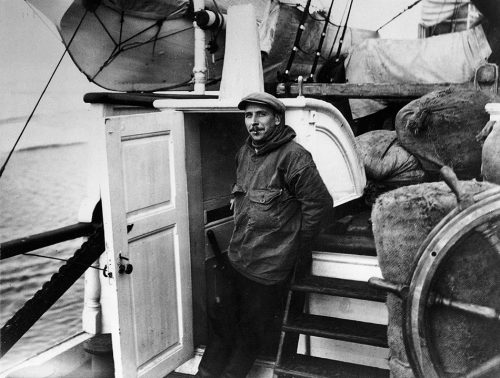
Dynamic habitat
Coastal contours are often viewed as fixed and immovable. People try to maintain a fixed line, not least of all to protect cities and systems that have developed and are concentrated at the coasts. But generally there is hardly any other area that is so dynamic and undergoes so much constant change as do the coasts. Experts call it a transient habitat. Depending on the time span being considered, different kinds of change can be observed. The slowest, but at the same time most drastic changes that coastlines undergo are caused by the motions of the continents. Movement of the continents was first postulated by the German researcher Alfred Wegener, who published his theory of continental drift in 1912. In the subsequent decades this theory was constantly expanded and improved. Today it is called plate tectonics. It states that the Earth is comprised of multiple layers, the uppermost of which, the lithosphere, is slowly moving. The lithosphere is made up of numerous large plates that lie side by side and move relative to each other by as much as 10 centimetres per year. The lithosphere includes the continents, but carry also the large ocean basins. It has an average thickness of around 100 kilometres and glides along atop a second Earth layer called the asthenosphere.
- 1.3 > Crustal material is created and destroyed at time scales of millions of years. In a continuous cycle, the individual continental plates collide, drift, and change their position relative to one another. It is possible to break the cycle down into individual stages, some of which are named after a present-day region that represents that stage. John Tuzo Wilson, a Canadian geoscientist, was the first to describe these cycles.

- In some places one lithospheric plate is thrust over another, causing upward folding of the rocks over millions of years and forming high mountains like the Himalayas. In other regions the plates slide along beside each other or drift apart. Coastal regions and the shallow marine areas called shelves are especially affected by these movements because they are situated on the margins of the continental parts of the plates, and are thus strongly deformed by the drifting of the continents.
Today, the vestiges of coastal seas such as fossilized bivalves, snails and other organisms of the shallow coastal waters can be found in many mountain ranges worldwide, including the Alps.
Continental drift also changes the shape of coasts by another mechanism. When a mountain range is crea-ted on land by uplift and folding, that is, when part of a continental plate is thrust over another and rises out of the water, one result is a drop in sea level. However, sea level can also rise to the extent that magma gushes in at the mid-ocean ridges, displacing large volumes of water.
Breakup of the supercontinent
Throughout the Earth’s history many alternating tectonic phases have occurred. There have been times when the continents were connected to form a single supercontinent or a few large continents. These were followed by phases when the giant and large continents drifted apart again. These repeating sequences are named the Wilson cycle, after the Canadian geologist John Tuzo Wilson who first described this principle in a journal article in the 1960s. The most recent cycle began about 300 million years ago when the continental plates collided to form the supercontinent Pangaea. Around 230 million years ago Pangaea began to break apart again, separating first into a northern (Laurasia) and a southern part (Gondwana). In the second phase, beginning about 140 million years ago, Gondwana split into the land masses that eventually developed into present-day Africa, South America, India and Australia.
- 1.4 > Continental plates carry both the land masses and the oceans. They move at speeds of up to several centimetres per year. At some places the continental plates move away from each other, for example, at mid-ocean ridges. At other places plates are thrust over or under one another. The Indian plate is being subducted below the Eurasian Plate, causing continued growth of the Himalayas.

 1.5 >Millions of years ago the continental plates formed a largely contiguous land mass, the supercontinent Pangaea. At that time the Atlantic Ocean did not exist.
1.5 >Millions of years ago the continental plates formed a largely contiguous land mass, the supercontinent Pangaea. At that time the Atlantic Ocean did not exist.- The breakup of Laurasia began around 65 million years ago with the separation of the North American and Eurasian land masses. This opened the North Atlantic, and India drifted more than 6000 kilometres to the northeast to collide with the Eurasian Plate about 40 million years ago. Over time the Himalayas were thrust and folded upward. India is still drifting northward today, causing the Himalayas to grow about one centimetre higher each year.
Evolutionary biologists believe that the early phase of the breakup of Pangaea, associated with the formation of new coasts, favoured the origin of new species.
Life goes ashore
As a result of the drifting of continents, coasts were not only created and destroyed, but also moved laterally. Entire coastal regions drifted into different climate zones, resulting in adaptation by existing organisms and the emergence of new life forms.
- 1.6 > Evidence for movement of the continental plates can be seen in Iceland. The island lies partly on the Eurasian and partly on the North American Plate. These two plates are drifting apart by a few centimetres every year. The fissure that cuts across the island is called the Silfra rift.
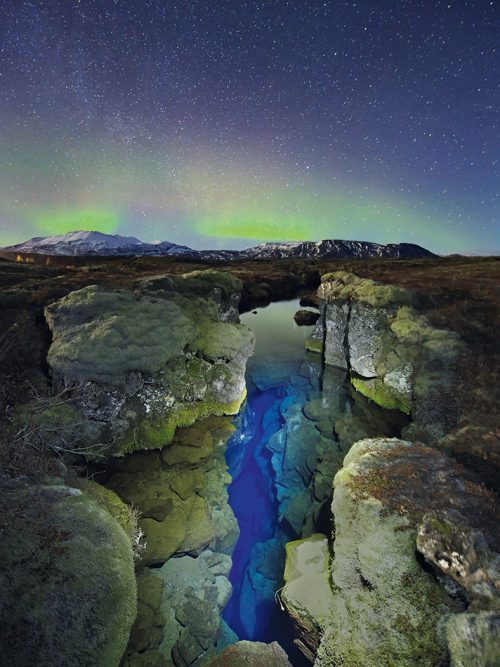
Extra Info Evolution of the eel – a matter of continental drift

- An interesting aspect of these developments is assessing the role of coasts in the transition of life from the sea onto land. Today it is generally accepted that the first life forms developed in the sea and expansion to the land occurred at multiple locations at different times and at different rates. This took place within different groups of organisms completely independently of one another. It is thought that the arthropods, a group with jointed appendages that includes crustaceans, insects and spiders, settled on land independently of vertebrates. Genetic analyses have shown that the ancestors of present-day insects made the transition from an aquatic to terrestrial life habit around 480 million years ago.
- 1.8 > Whales evolved from land mammals. Their terrestrial provenance can be recognized by the fact that they move their tail fins vertically, using the same up-and-down motion that large predatory cats employ. By contrast, fish move their tail fins horizontally back and forth.
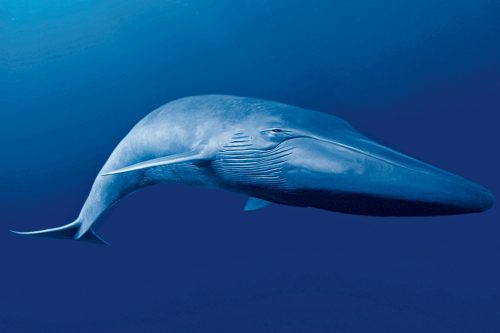
- It is assumed that the move to land for vertebrates began around 415 million years ago and lasted until about 360 million years ago. The first land vertebrates presumably evolved from the bony fishes. The first amphibian creatures may have been animals of the genus Kenichthys. Remains of this small animal, whose skull is only a few centimetres long, were found in China and have been age-dated at about 395 million years. It is possible that they preyed on insects at first. They might also have settled in near-coastal wetlands, river estuaries, wet river banks and brackish water areas where river water mixed with sea water. Among amphibians today there is still an animal group that lives both in the water and on land. Toads need water to reproduce. The development of their larvae takes place in water. For the adult animals, on the other hand, land is the predominant habitat, where they mate and hunt for prey.
Coasts as a bridge between sea and land
Fish of the sturgeon family also exhibit an amphibious adaptation. Sturgeons live primarily in the sea, but seek out freshwater areas to spawn. Interestingly, in addition to the gills typical for fish, sturgeons also have lung-like organs, small cavities in the skull. With a gulping action they fill these with air and can extract oxygen from it – presumably as an adaptation to possible arid conditions. Thanks to the ability to breathe air a sturgeon can survive these dry periods, for example, when a stream or lake shore dries up or carries less water for a short time.
But coasts have also played a role in the opposite direction by facilitating the return of life forms from land back into the sea. Today there are numerous animals whose ancestors lived on the land that have now readapt- ed to the marine habitat. Whales, for example, derive from four-legged land animals, but their two rear appendages have regressed to rudimentary stumps of bone. Their mode of swimming, however, is similar to the motion of some four-legged animals on land whose lower body moves up and down at a fast run. The fluke, or tail fin, of the whale moves in a similar way because the spine and skeleton are still much the same as those of the land mammals. By contrast, fish move their tail fins horizontally back and forth.
Some turtle species have also made the return from the coast back into the water, although they had originally evolved as four-legged land animals. Sea turtles have developed an amphibious habit, living between the land and sea. Many of these species search out a beach to lay their eggs at spring tide when the water reaches especially high levels. They can thus bury the eggs in the sand high up on the beach where they are protected from flooding. Later the hatchlings also break out during a spring tide, when the water is high again and the arduous and dangerous journey back across the beach into the sea is shortest.
Highs and lows through the millennia
Not only do coasts change their shape at a scale of millions of years, significant changes also occur over much shorter time periods. In cycles with magnitudes of several tens of thousands of years, alternating warm periods and ice ages, with the accompanying sea-level changes, play a significant role.
During the ice ages large areas of the land masses freeze. Precipitation in the form of snow forms glaciers thousands of metres thick. Because large volumes of water are bound up in ice on the land, and river flow into the sea is diminished, sea level falls gradually during an ice age.The most recent ice age ended around 12,000 years ago.The last period of heavy ice cover on the Earth was from 26,000 to 20,000 years ago. Sea level then was about 125 metres lower than today. Broad regions of the northern hemisphere were covered with glaciers, to as far as the Netherlands in central Europe. In warmer regions of the Earth the coastline looked completely different than today.
Around 15,000 years ago temperatures on the Earth began to rise rapidly again. This warm phase is still continuing today. The last warm phase before this one to see temperatures comparable with today’s occurred between 130,000 and 118,000 years ago. Sea level at that time was about four to six metres higher than it is today.
The big melt
Sea level rose again with the melting of glaciers after the last ice age. This rise generally proceeded steadily but there were occasional periods of accelerated rise triggered by events called meltwater pulses. These involved large amounts of meltwater that were released within a relatively short time. One significant event was a meltwater pulse that began about 14,700 years ago and lasted 500 years. The cause of this, presumably, was calving of the large glacial masses in the Antarctic, or in the Arctic between Greenland and Canada. With the melting of glaciers, sea level rose globally during this time by around 20 metres. Other large events included the runoff of immense dammed lakes that had formed from the meltwaters of retreating inland glaciers. According to scientific estimates, Lake Agassiz in North America had a maximum area of around 440,000 square kilometres, making it even larger than today’s Great Lakes.
- 1.9 > At the peak of the last ice age sea level was around 125 metres lower than today. The total global land mass protruding out of the water was about 20 million square kilometres greater.

- It broke through the surrounding glaciers multiple times, pouring large amounts of fresh water into the ocean, with one especially significant episode around 8200 years ago. This one meltwater pulse alone is believed to have raised sea level by several metres within just a few months. The magnitude of sea-level change since the last ice age can be reconstructed based on various lines of evidence, for example, by studies of coral reefs or sediments on the sea floor. Tropical coral banks on the slopes of South Pacific islands have been growing slowly upward along with sea-level rise over recent years and decades. They can only grow in shallow water that is flooded by sufficient light. When sea level rises, the zone in which corals can thrive also shifts slowly upward. By drilling deep into the coral banks, older dead corals are encountered whose age can be determined by special analytical methods. Sea-level elevation at different times can thus be estimated.
- 1.10 > Sea level has not risen at a constant rate over the years. It has been punctuated by surges resulting from events such as meltwater pulses.

- The second method involves detailed study of sediments on the sea floor. By examining microfossils found in the sea-floor sediments, including the remains of single-celled organisms or fossilized fish bones and teeth, it is possible to determine when the bottom was part of the exposed land area, whether it was covered by fresh water from the melting glaciers, and when it was finally flooded by salt water from rising sea level. Depending on environmental conditions, different organisms are present and their organic remains are concentrated there. A sediment layer that derived from land plants can thus be clearly distinguished from one in which the remains of marine algae are found.
- 1.11 > The Earth changes its precession, the rotation motion, over a period of about 23,000 years. This is comparable to a gyroscope that gradually begins to wobble. It continues to rotate but the axis makes increasingly large circles.
The sun – a climate engine
The cause for alternating warm and cold phases, with the associated rise and fall of sea level, is related to natural climate fluctuations at regular intervals. Milankovich Cycles, postulated by the mathematician Milutin Milankovi´c in the 1930s, could have had an influence on the warm and cold periods. His theory maintains that the position of the Earth relative to the sun changes regularly, causing variations in the amount of incoming solar radiation received by the Earth. These variations particularly affect the northern hemisphere. According to Milankovi´c there are three primary causes:- Change in the precession of the Earth’s axis, which varies on a cycle of around 23,000 years. Precession can be best explained by a spinning top that has been disturbed by a gentle push. The top continues to rotate, but the axis direction defines a larger circle. The cyclical change in direction of the axis is called precession.
- Change in the tilt angle (inclination) of the Earth’s axis, with a cycle duration of around 40,000 years.
- Change in the eccentricity of the path of the Earth around the sun. The shape of the elliptical orbit of the Earth varies. The change occurs in cycles of around 100,000 years and 400,000 years.
- It is known today that the Milankovitch Cycles alone cannot explain the large temperature differences between warm phases and ice ages. But it is very probable that they contribute greatly to the change. There is also an amplifying effect that contributes to the origin of ice ages: the ice-albedo feedback. Ice and snow strongly reflect sunlight (the ratio of reflection is called albedo). The thermal radiation of the sun is thus also reflected, which results in further cooling. The growth of glaciers is thus enhanced.
Changing sea level – the pulse of human evolution
The rise and fall of sea level changed the available land area significantly with each cycle. Many areas that are flooded today were dry at the peak of the last ice age when sea level was about 125 metres lower. The land area in Europe was almost 40 per cent greater than it is today, and worldwide it was about 20 million square kilometres larger, which is approximately equal to the area of Russia. People thus had more extensive areas available that could be used for fishing, hunting and settlements. Experts believe that humans were already practising navigation then. At that time many land bridges between present-day islands and the mainland were still above sea level. Pathways that no longer exist today were available to people for exploiting new areas. These include the northern connection between America and Asia, which is cut off today by the Bering Strait. Another example is the 500-kilometre wide Arafura Sea, the marine region between Australia and the island of New Guinea to the north, which is an important fishing area today but was dry land at the peak of the last ice age.
Out of Africa
Today, it is widely accepted that humans originated in East Africa. The following important epochs of their dispersal are recognized. The first was around two million years ago. At this time the early man Homo ergaster/Homo ercetus spread, presumably by land, to Europe, China and down to southern Africa. Whether Homo ergaster and Homo erectus are related, and to what extent, is an object of ongoing research. It is conclusive, however, that both became extinct and were not direct ancestors of modern humans, Homo sapiens.
- 1.12 > The early man Homo ergaster had many of the skills of modern humans. He made tools. This could have helped in his migration two million years ago from Africa to the north and east.
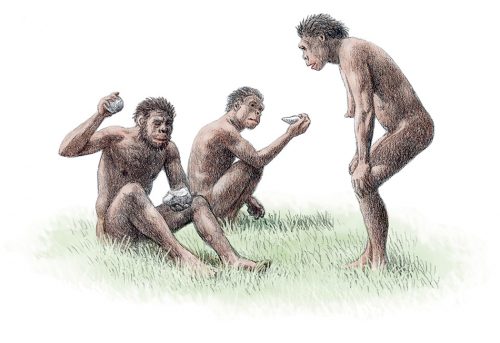
- The second epoch involves Homo sapiens, who had a significantly wide range almost 200,000 years ago. Around 50,000 years ago they migrated to New Guinea from present-day Indonesia and finally to what would become the continent of Australia. New Guinea, which belongs half to Indonesia and half to Papua New Guinea, was separated from the rest of Indonesia by the sea, like today. But by that time, according to experts, the people already had simple boats and basic nautical skills. During this phase navigation on the water, from coast to coast over large distances, already played a role. America, however, was reached and colonized by crossing the land bridge in northern Asia about 15,000 years ago. Much of the evidence of these early human migrations is covered by water today, so there is often an absence of relics or prehistoric indicators of settlements. It is presumed, however, that people spread primarily along the coasts. Inland forests would have made migration difficult over the land, so the coastal pathways were simpler. In addition, fish and seafood were a reliable source of food. With the end of the last ice age, the conquest of new areas by Homo sapiens also received a boost. As the glaciers thawed they made room for modern humans, who were now able to spread northward as far as the arctic regions.
Modern technology reveals old clues
To better reconstruct the spread of humans and to evaluate the importance of coasts, specialists from various disciplines have been collaborating intensively for several years. Teams comprising geologists, archaeologists and climatologists have joined forces to search for the traces of early settlements and, using modern submersible vehicles and high-resolution echo-sounder technology, to reveal structures in the sea floor in great detail. Underwater archaeology is important in this endeavour because areas on land have been continuously altered by people over thousands of years, while some evidence on the sea floor – including stone-age – has been covered and protected by sediment layers. Near the coasts, scientists now search systematically for underwater caves that were above sea level and dry during the ice age. These caves were used in the past as living areas and could hold interesting clues.
New knowledge is now being obtained from many areas of the world, for instance of the settlement pathways between Africa and Europe in the Mediterranean region. It was long believed that modern humans from Africa advanced to the north by land, along the eastern margin of the Mediterranean. But new finds indicate that migration over the sea from coast to coast must also be considered as a possibility. At present, there are ongoing intensive studies of the role that Malta, an island archipelago between Tunisia and the Italian island of Sicily, could have played. It may have been an important bridge between the two continents. At the peak of the last ice age Malta was significantly larger and was connected to present-day Sicily over a 90-kilometre long land bridge called the Malta-Ragusa Platform, so that the distance northward from Africa across the Mediterranean was much shorter than it is today.
The sea floor around Malta has been mapped in detail in recent years with the help of modern underwater technology. Bottom samples have also been taken. Ancient land structures on the sea floor that have hardly changed over thousands of years became visible: old river valleys, sand banks, stone-age shore lines and possibly even old lakes. In the past, the three present-day islands of the Malta archipelago were connected and there were evidently large fertile areas that would have been of great interest for settlers from Africa. According to the researchers, the trip would have been possible with simple boats. Efforts to find concrete evidence of early settlements are continuing.
Evidence of early settlements is also being sought on the sea floor 200 kilometres to the northwest. There lies the small island of Pantelleria, directly upon the shortest line between Tunisia and Sicily. It is known for its occurrences of obsidian, a black, glassy volcanic rock that was used by stone-age people. Scientists searched a small area for chipped obsidian and were successful. The flaked stones appear to be concentrated at an ancient shoreline that lies below 20 metres of water today. Closer investigation should be able to determine whether it is a stone age find. The scientists believe this is probable.
Sundaland – a melting pot for humanity
Efforts are also being made in Southeast Asia to locate flooded shorelines where evidence of prehistoric settlements may be found. The challenge here lies in the sheer immensity of the ocean region to be investigated. During the last ice age, the present-day marine area between the Asian mainland and the islands of Borneo, Java and Sumatra was a large contiguous land mass that is called Sundaland, and was at that time as large as Europe. Scientists believe that the climate and vegetation in parts of Sundaland changed repeatedly. During some periods there were dense rain forests and at others savannah landscapes predominated. These fluctuations led to periodic large-scale migrations. People migrated from the northern regions to Sundaland. At other times they moved in the opposite direction. Thus, according to genetic models and a few archaeological finds, different tribes intermingled repeatedly at certain times. The region was a genetic melting pot that probably played an important role in the development of modern humans. It is further assumed that during times when the savannahs were predominant, the people moved over particular corridors or plains, possibly also on elevated plains along the coasts.
Much is still unknown about the settlement history of this region. This is regrettable because the region represents an important stepping stone in the colonization of New Guinea and Australia, which were a contiguous land mass called Sahul during the last ice age. A land connection between Sundaland and Sahul, however, can confidently be ruled out because the marine area between them, the Banda Sea, was up to 5800 metres deep even at that time.
The Baltic Sea – a young coastal sea
Different factors played a role in the settling of the northern hemisphere as compared to the southern hemisphere. In addition to changes in sea level, the ice masses of glaciers also had an enormous influence on the natural environment and on the history of human settlement. The Baltic Sea is a good example of the extreme changes in landscape. Its history can be fairly accurately reconstructed based on numerous sedimentological studies. It began around 12,000 years ago when the glaciers of the last ice age had retreated back to as far as Scandinavia. At that time sea level stood about 80 metres below its present level. A meltwater lake formed near the centre of the present Baltic Sea, initially with no connection to the open sea because the present-day Kattegat Strait between Denmark and Sweden was still situated above sea level, and was thus dry land. It would have been possible to walk on dry land along the shore of this lake from the present site of Rügen Island to the area of the Danish island of Bornholm.
- 1.13 > Around 18,000 years ago the North Sea was largely dry land. The area between present-day Great Britain, Denmark, Germany and the Netherlands is called Doggerland, although the exact locations of land masses, glaciers and rivers are uncertain. Doggerland shrunk with the rising sea level until it completely disappeared about 7000 years ago.

- With rising sea level, as a result of meltwater pulses, this land connection was flooded some 10,000 years ago. However, the connection to the open sea was cut off again about 9300 years ago due to the gradual uplift of the Scandinavian land mass. During the ice age the weight of glaciers caused the land to subside, but this decreased steadily with the thaw. Incidentally, the rebound of Scandinavia is continuing today at a rate of approximately nine millimetres per year.
As a result of the meltwater pulses and accelerating sea-level rise, however, the Kattegat Strait was irrevocably flooded around 8000 years ago.
Disappearing land
At this time the North Sea was also formed. Until about 10,000 years ago the area between present-day Netherlands, Germany, Denmark and Great Britain was still a large contiguous land mass. It was crossed by large rivers that can be seen as precursors to the Rhine, Weser, Thames and Elbe Rivers. At that time they emptied into the sea several hundred kilometres further to the north than today. Archaeological evidence indicates that the landscape was characterized by moors and birch forests. This area is now called Doggerland, after the Dogger Bank, a shoal present in the North Sea today.
Discoveries of hunting weapons prove that people lived here during the Middle Stone Age or Mesolithic. Rising sea level also flooded Doggerland so that people living near the river mouths had to gradually retreat from the coasts. By around 7000 years ago it had probably completely disappeared. Sea level at that time was about 25 metres below the present level.
Today, the floors of the North Sea and the Wadden Sea on the Dutch, German and Danish North Sea coasts are largely covered with sand and soft sediments that the precursor rivers had carried far out into Doggerland. The cliffs of Heligoland probably projected as an imposing mesa above the vast plain. They are part of a red sandstone layer that actually lies 2000 metres underground but was pushed upward by an enormous salt dome that formed 100 million years ago and underlies the sandstone.
- 1.14 > 12,000 years ago people used axes and daggers made of flint from Heligoland. At that time Heligoland, part of a colourful sandstone formation, protruded as a prominent mesa above Doggerland.
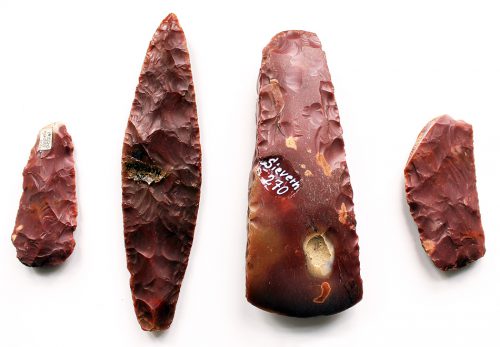
-
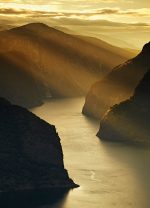 1.15 > The Sognefjord is one of the most popular travel destinations in Norway. It was formed during the ice ages by glaciers that slid into the sea here and gouged out the rock below. As the glaciers thawed and sea level rose, the glacial valley was slowly flooded.
1.15 > The Sognefjord is one of the most popular travel destinations in Norway. It was formed during the ice ages by glaciers that slid into the sea here and gouged out the rock below. As the glaciers thawed and sea level rose, the glacial valley was slowly flooded. Meltwater disrupts the marine heat pump
With regard to life on the coasts, the most direct impact of the onset of warming 20,000 years ago was the rise in sea level and flooding of large regions. But the presence of Lake Agassiz in North America, which repeatedly released large meltwater pulses into the sea, again exemplifies the fact that these climate changes had other, much further-reaching consequences for people. At this time the northern hemisphere had already warmed significantly compared to conditions during the ice age. The massive release of fresh water interrupted this trend and led to renewed cooling of the northern hemisphere by up to 5 degrees Celsius. The reason is that the surge of fresh water into the Atlantic disrupted the oceanic heat pump, the global thermohaline circulation that moves water worldwide like a giant conveyor belt (thermo – driven by temperature differences; haline – driven by salinity differences). Through this phenomenon, which occurs in polar marine regions, cold, salty and comparatively heavy water sinks to great depths and flows toward the equator. As the surface water sinks, warm water flows in from the southern regions to replace it. The Gulf Stream, whose branches and extensions transport warm water from southern latitudes to the northeast, and which contributes to Western Europe’s mild climate, also depends on this phenomenon.
Even at the time of Lake Agassiz this heat pump led to relatively warm climatic conditions in the northern hemisphere. Discussions continue among specialists regarding the extent to which the meltwater pulses reduced salinity, and whether the thermohaline circulation completely stopped. It follows that a halt in the circulation would also interrupt the transport of warm water from southern ocean regions. The climate in Europe and the Near East became cooler and dryer. These changes could have had a decisive impact on human history, particularly on the Neolithic revolution, which began about 10,000 years ago. Many humans made a lifestyle transition from hunters and gatherers to sessile farmers and livestock breeders. There are various scientific theories for this transition. One explanation is the “oasis” hypothesis (also known as the “propinquity” or “desiccation” theory). This states that the hunters and gatherers could no longer find enough food, especially because certain prey animals became scarcer due to climate change, meltwater pulses and interruption of the thermohaline circulation. As a result people began to cultivate types of wild grain that grew well in the new prevailing climate.
With the thawing of glaciers the meltwater flow from Lake Agassiz gradually diminished, resulting in higher salinity in the Atlantic again. This gradually restarted the thermohaline circulation, causing temperatures in Europe and the Near East to rise again.
In summary, a comparatively strong rise in sea level began around 20,000 years ago and lasted until about 6000 years ago. Since then, sea level has only varied slightly, with fluctuations of a few centimetres per century. Now with the global warming caused by human activity, the rise has accelerated noticeably again in recent decades.
Glaciers shape coasts
Alternating warm periods and ice ages change coasts, but not only through the rising and falling of sea level caused by glacial melting and growth. They also influence the form of the coastal landscape. During the ice age, glacial ice packages several kilometres thick placed a heavy load on extensive areas of the northern hemisphere land masses. Glaciers typically move slowly across the underlying rocks. One way they move is by gliding on a film of meltwater that forms from ice at the base of the glacier under high pressure. They also move slowly as the ice undergoes internal plastic deformation under its own weight. The migrating glaciers act like giant planers that shape the coasts in different ways. The Stockholm coastal archipelago, for example, consists of 500-million-year old solid granite and gneiss that even a glacier could not strip away, but it abraded the rocks into smooth round hills. Geologists call this kind of region a glacial drumlin landscape. Rising sea level then transformed this region into an archipelago.
- 1.16 > The Stockholm coastal archipelago is composed of very hard granite and gneiss rocks that were abraded to gently rounded hills during the ice age.
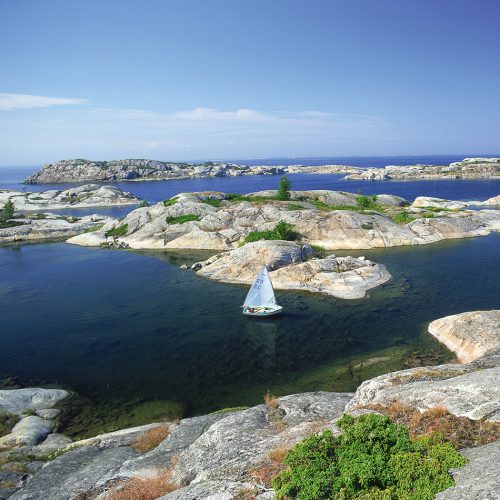
- On the steep coast of Norway, by contrast, the round glacier tongues dug deep into the rock and created typical valleys that are sometimes very deep and have a u-shaped cross section. The Sognefjord, for example, presently has a depth of 1000 metres.
The physical character of the land in North Germany, on the other hand, is different. Here the bottoms are relatively soft and very wide glacier tongues formed that pressed the coastal lands downward and at the same time abraded them horizontally. Examples of this include the wide openings of the Kieler Förde and the Eckernförde Bay.
